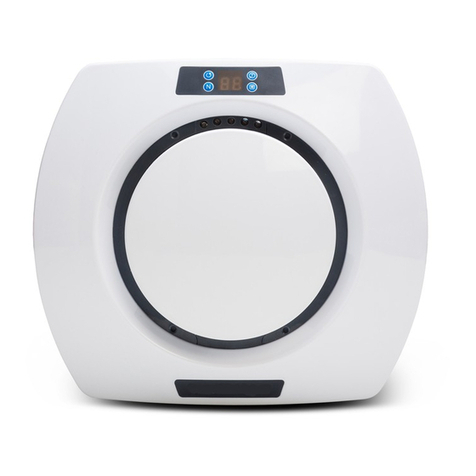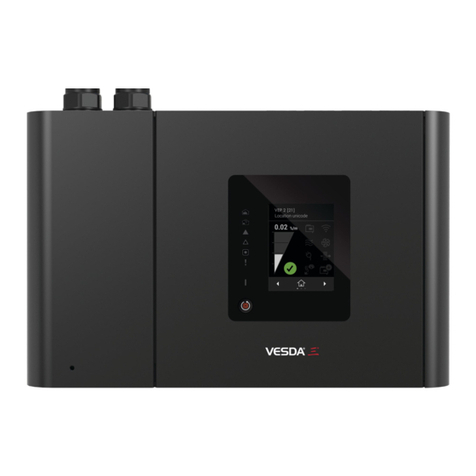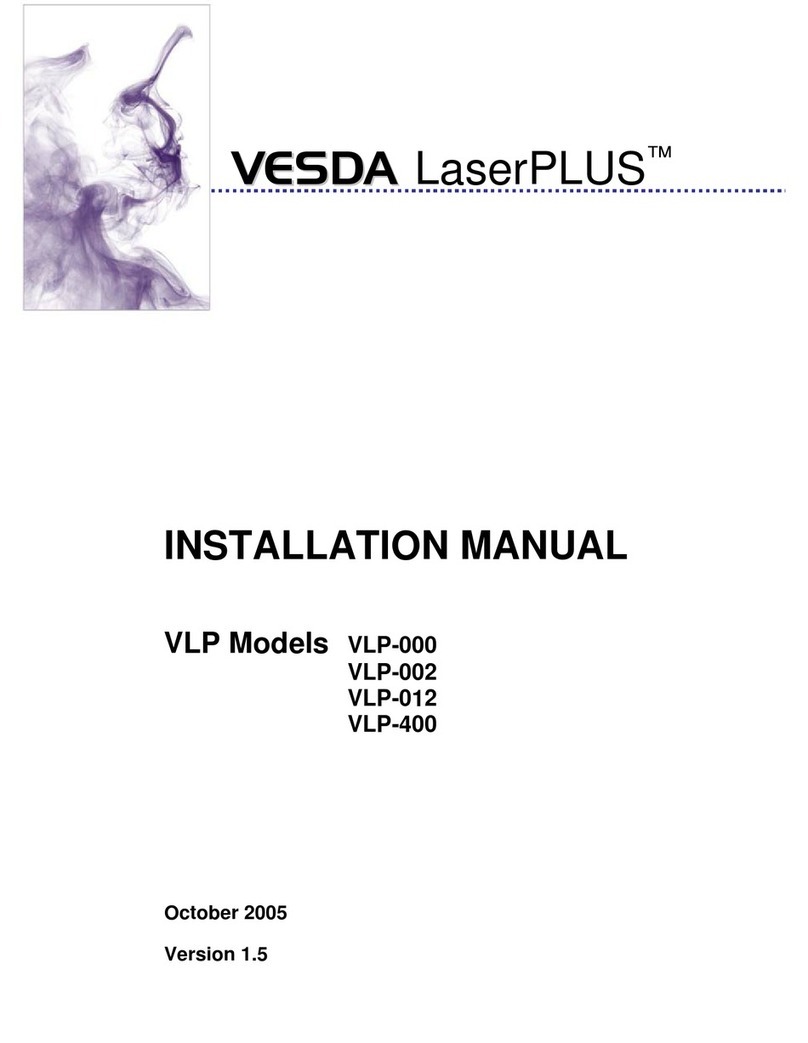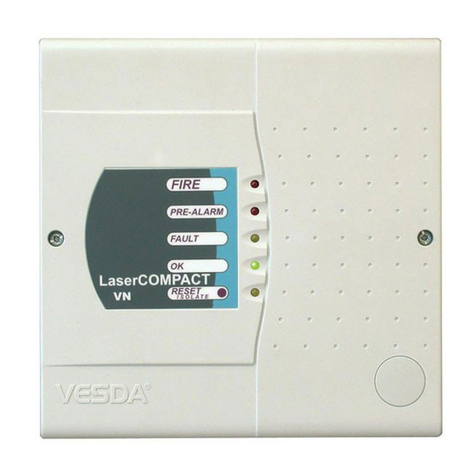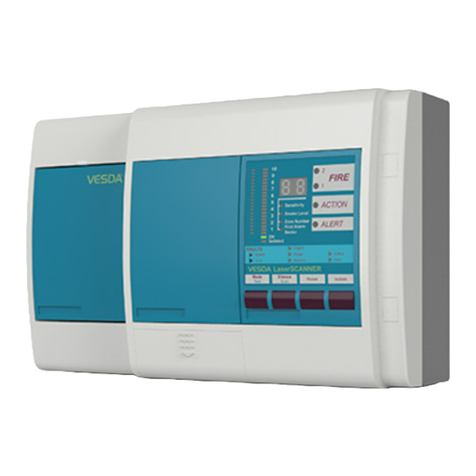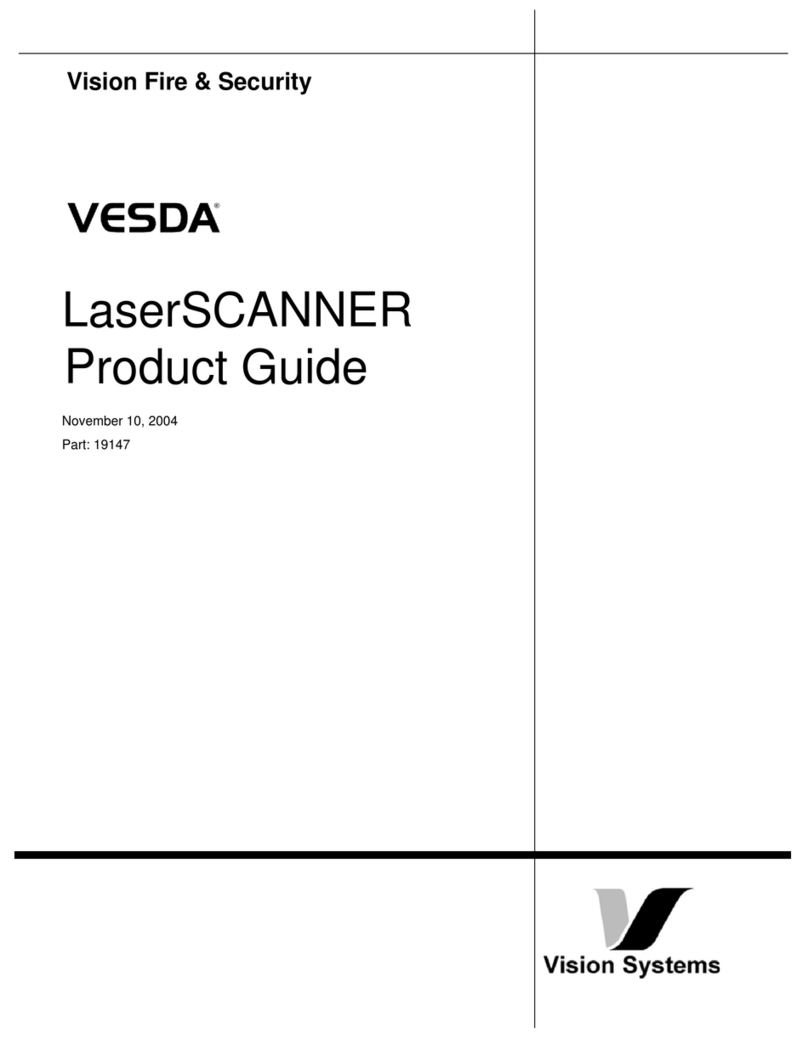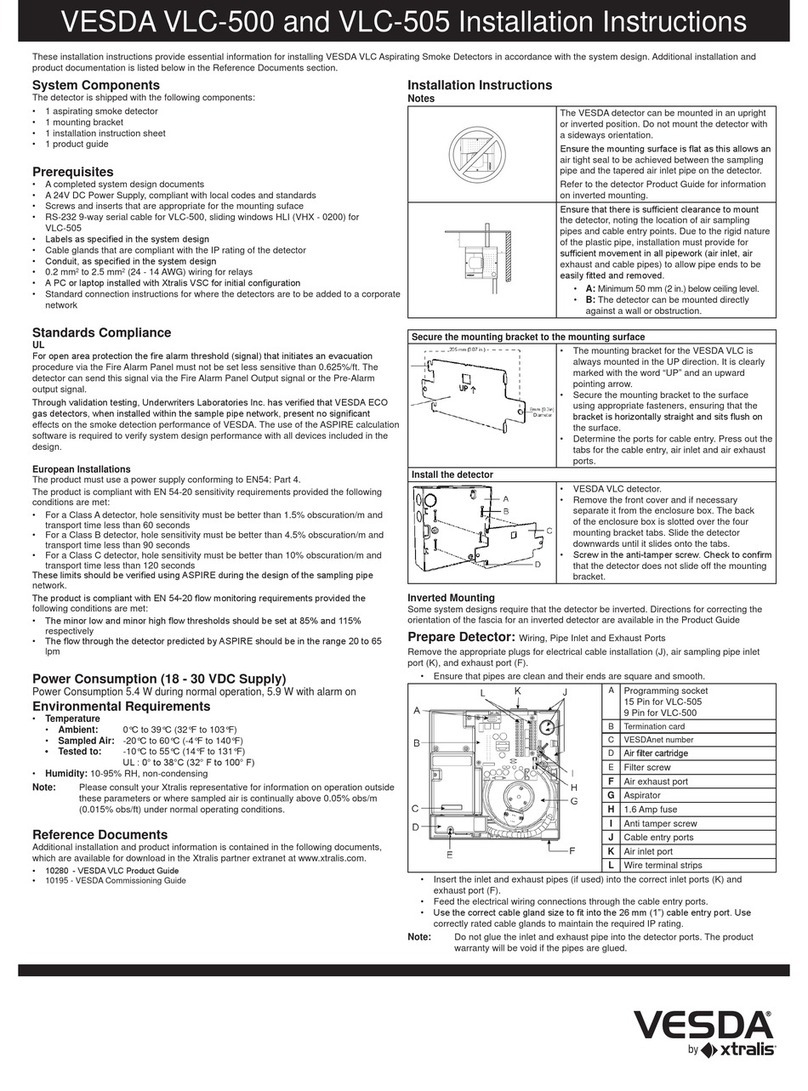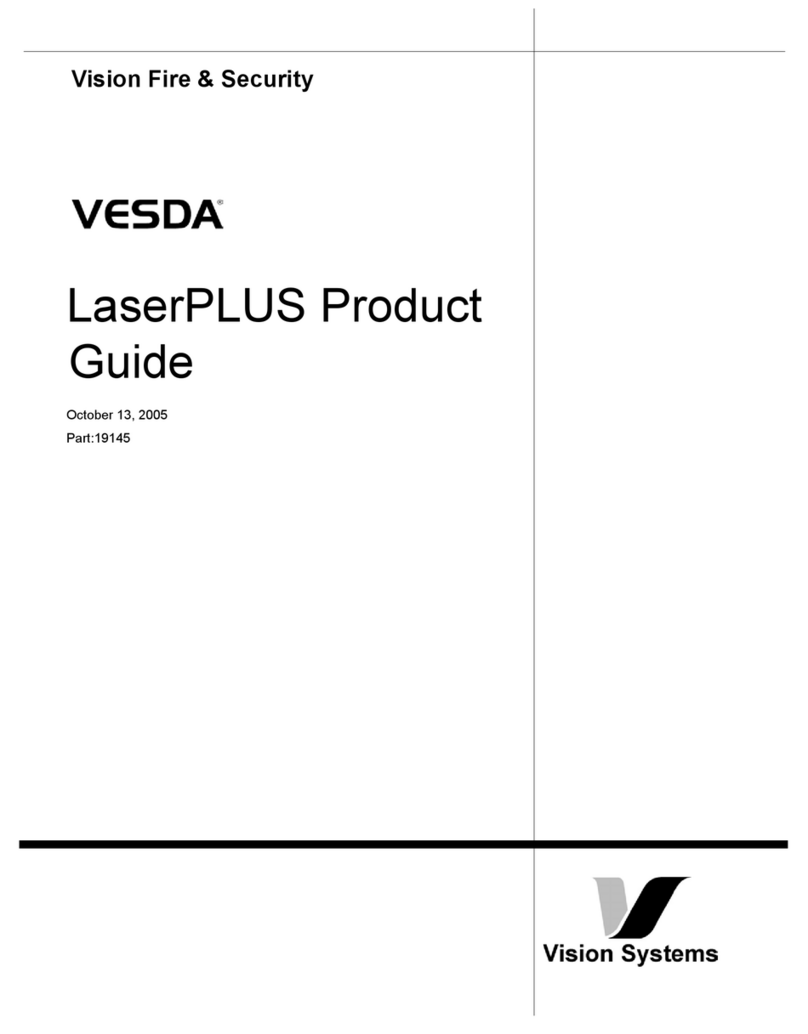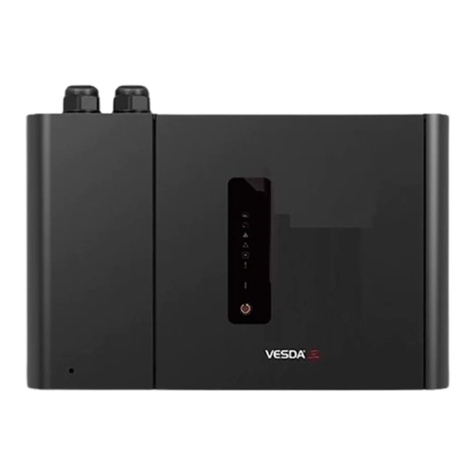
The contents of this document are provided on an “as is” basis. No representation or warranty (either express or implied) is made as to the completeness, accuracy or reliability of the contents of this document. The
manufacturer reserves the right to change designs or specications without obligation and without further notice. Except as otherwise provided, all warranties, express or implied, including without limitation any implied
warranties of merchantability and tness for a particular purpose are expressly excluded.
Xtralis, the Xtralis logo, The Sooner You Know, VESDA-E, VESDA, ICAM, ECO, OSID, HeiTel, ADPRO, IntrusionTrace, LoiterTrace, ClientTrace, SmokeTrace, XOa, XOh, iTrace, iCommand, iRespond, iCommission,
iPIR, and FMST are trademarks and/or registered trademarks of Xtralis and/or its subsidiaries in the United States and/or other countries. Other brand names mentioned herein are for identication purposes only and
may be trademarks of their respective holder(s). Your use of this document does not constitute or create a licence or any other right to use the name and/or trademark and/or label.
This document is subject to copyright owned by Xtralis. You agree not to copy, communicate to the public, adapt, distribute, transfer, sell, modify or publish any contents of this document without the express prior written
consent of Xtralis.
www.xtralis.com
UK and Europe +44 1442 242 330 The Americas +1 800 229 4434
Middle East +962 6 588 5622 Asia +86 10 5669 7101 Australia and New Zealand +61 3 9936 7000
Part: AD30356-000
VESDA-E VEP Installation Instructions
Prepare Detector: Wiring, Pipe Inlet and Exhaust Ports
Remove the appropriate plugs for electrical cable installation (B), air sampling pipe inlet ports (A), and
exhaust port (C).
• For VEP-P detectors, where the system design requires less than four air sampling pipe inlet ports,
use ports 2 and 3 before using ports 1 and 4.
• For VEP-1P detectors, use port number 1.
• Do not remove the plugs from inlet ports that will not be used.
• Ensure that pipes are clean and their ends are square and smooth.
A
B
C
E
12
INLETS A Inlet Port, Qty 4
B Cable Entry Port, Qty 4, 26 mm (1”)
CExhaust Port, OD 25 mm or 1.05” (3/4” IPS) via adaptor
DInlet Pipe Diameter: OD 25 mm or 1.05” (3/4” IPS)
E Minimum Inlet Pipe Length: 500mm (19.6”)
• Insert the inlet and exhaust pipes (if used) into the correct inlet ports (A) and exhaust port.
• Exhaust pipe should be as short as possible.
• Feed the electrical wiring connections through the cable entry ports.
• Use the correct cable gland size to t into the 26 mm (1”) cable entry port. Use correctly rated cable
glands to maintain the required IP rating.
Note: Do not glue the inlet and exhaust pipe into the detector ports. The product warranty will be
void if the pipes are glued.
Wiring: Power, Relays, GPI, Loop Module, VESDAnet, Standalone Detector
Warning: Always switch detector power OFF before plugging/unplugging electrical, relay or network
connections. Failure to do so may cause data corruption and/or component failure.
Avertissement : Eteignez toujours détecteur avant de brancher/débrancher les relais électriques, ou de
connexions réseau. Au cas contraire vous pouver entraîner la défaillance corruption et/ou
élément de données.
FM Hazardous Locations
Suitable for Class I, Div. 2., Groups A,B,C and D. T5 (Ta = 0C to +40C)
Ensure grounding ‘ring connector’ is assembled and wired into building ground. See diagram below.
SHSH
NC NOC CNC NO NC NOC
2 [ F]MINOR
NC NOC
1 [ ]ISOL
5 [ ]ACTION
NO NCC
6 - 1FIRE
NO NCC
7 [ 2]FIRE
CNO NC
A
B
C
D
H
G
F
E
I
J
K
L
M
O
N
4 [ ]ALERT
3 - FURGENT
P
Q
Power
APower Out
BPower In
VESDAnet
CVESDAnet B
DVESDAnet A
Relays
E1 - Isolate (Disable)
F2 - Minor Fault
G3 - Urgent Fault
H4 - Alert
I5 - Action
J6 - Fire 1
K7 - Fire 2
Communications
LUSB
MEthernet
GPI
NMonitored GPI
OUnmonitored GPI
Reference
PReference Terminal
For UL/ULC installations connect to local
ground to enable ground fault detection on
VESDAnet
Chassis Ground
QChassis Ground Terminal
For FM Hazardous locations, connect this
terminal to building ground.
Power and Relay Wiring
Power: There are two sets of power terminals on the main board. Connect a 24 VDC power supply to the
PWR IN socket (B). If required, connect to another detector via the PWR OUT socket (A).
Relays: The relays interface to the Fire Alarm Control Panel (FACP) to communicate faults, alarms and
disabled states. Relay contacts are rated 2 A @ 30 VDC, resistive. Connect as required by the system
design. Use electrical wire sizes from 0.2 mm² to 2.5 mm² (24 -14 AWG). Refer to the Addressable Loop
Module example.
Warning: Ensure that all wiring complies with manufacturer’s instructions and local and national re
detection code requirements. Refer to Codes and Standards Information for Air Sampling
Smoke Detection section of the detector product guide for further information on wiring
compliance.
Avertissement : Verier que toute les cables ont passé au nombres d’instructions du fabricant et locaux et au
feu national de securited’incendie sois exiger. Adresser aux codes informations sur les normes
et reglementations de detection de fume par prelevement d’air par le notice descriptive du
produit pour plus de renseignements au conformite du cablage.
Caution: DO NOT LOOP WIRE UNDER TERMINALS WHEN WIRING DETECTORS.
BREAK WIRE
RUNS TO PROVIDE SYSTEM SUPERVISION OF CONNECTIVITY.
Attention : NE PAS RALIER LES CABLES TERMINAUX PENDANT LES CABLAGES DES FILS. POUR
TOUTES LES CONNECTIONS A RELAIS, INTERROMPRE LES FILS POUR PERMETTRE LA
SUPERVISION DU CABLAGE.
Note: For information on wiring for other types of devices that may be required by the system
design, refer to the detector Product Guide and documentation accompanying the device.
Unmonitored GPI
The Unmonitored GPI is a programmable input which can be congured to initiate a number of different
actions, including, by default, a Remote Reset function.
Monitored GPI
The monitored GPI senses contact closure and is congurable to initiate the same actions as the
unmonitored GPI. “Mains OK” is the default setting. A closed contact signals GPI ON and open contact
signals GPI OFF.
A 10K end of line resistor is used to allow the detector to monitor for open circuit faults in the wiring from
the detector to the contact.
Connection to Addressable Loop Module for Reporting Alarms and Faults
Normally Closed (NC)
Common (C)FIRE 1
(NO)Normally Open
Normally Closed (NC)
Common (C)ACTION
(NO)Normally Open
Dete torc
Fire Input
EOL* = Normal
Short = Fire
Open = Wiring Fault
3 Inputs Loop Module
Pre Alarm
EOL* = Normal
Short = Fire
Open = Wiring Fault
EOL*
EOL*
Relay shown energized which
is the no-fault condition
Normally Closed (NC)
Common (C)FAULT
(NO)Normally Open
Fault Input
EOL* = Normal
Detector FaultShort =
Open = Wiring Fault
EOL*
This wiring example is for wiring VESDA detectors
to a typical third party Input Loop Module with three
inputs.
This is an example drawing. Refer to the
appropriate product manual for the exact wiring
details of the third party equipment.
* EOL = End of Line Resistor
Connection to VESDAnet
A+
A-
B-
Shield
Module 2 Module 3
B+
A+
A-
B-
Shield
B+
A+
A-
B-
Shield
B+
A+
A-
B-
Shield
Shield
B+
A+
A-
B-
Shield
Shield
B+
(VESDA-E VEP)
The diagram shows an example of the wiring for a
closed VESDAnet loop, which is the recommended
conguration. Remove the factory default A and B
links from the VESDAnet sockets (C and D) prior
to connecting the detector to the VESDAnet. It is
recommended that 120 Ohm twisted pair cables
(e.g. Belden 9841) be used for including the
devices in the network, with a maximum length
between devices of 1.2 km The polarity of the data
wires must be maintained throughout the network.
Standalone Detector
A-
A+
B-
B+
The diagram below shows the factory default wiring for VESDAnet sockets (C and D)
as required for a detector that is not connected to a VESDAnet.
• Leave as is, or replace if it has been removed.
Communications
• USB: The USB port (L) is used for initial conguration and local maintenance or servicing of the
detector using a PC or laptop installed with Xtralis VSC software. Install Xtralis VSC prior to connecting
the detector to the computer. This ensures that the required USB drivers are present.
• Ethernet: The Ethernet port (M) is used for permanent network connection to the detector, and
provides a gateway to any other devices on the VESDAnet network. An Ethernet lead can be routed
through the cable entry ports and plugged into the Ethernet port. Use a standard Ethernet lead when
connecting the detector to a network switch, router or directly to a PC or laptop. Ethernet connection
must be congured using a USB connection prior to use. Set the detector access password using
Xtralis VSC.
Sampling Pipe Network
Complete the pipe network installation in accordance with the system design. Refer to the detector Product
Guide and the VESDA Pipe Network Installation Guide for general information regarding pipe network
installation.
• Ensure that the exhaust is open, the pipes are clear and all sampling holes have been drilled.
Power Up
Connect 24 VDC power to the Power In terminals (2). Close front door.
Conguration
For initial conguration, use a USB connection and the Xtralis VSC software.
• For networked detectors, set the IP address and subnet mask according to standard building
instructions.
• Set the Pipes in Use value in the Airow conguration options.
• Set the aspirator RPM to the value specied in the system design.
• Let the detector run for approximately 2 minutes and conrm that the pipe raw ow rates (L/min) match
the ASPIRE predictions using Xtralis VSC.
• Normalize the airow. This takes approximately 10 minutes, after which the pipe ow rates (%) should
be close to 100%.
• Reset the detector. It should now be running without faults.
Commissioning
• Carry out a smoke test. Refer to the product guide for further information.
Document: 22209_A7, September 2020
Note: To remove the pipe inlet and cable entry port
plugs, place a large screwdriver in the large
slot and twist, or use a small screwdriver in
the side slots to lever the plug out.
Fasten Hex Standoff - Part No.
971200481
To clinch nut on the back plate
through the main board and
ESD cover. M4 Star Washer
Ring Connector
Fit the Locking Washer
to the Hex Standoff.
Ensure side bends
mate up with the at
sides of the standoff.
M4 x 8 Threaded
Screw
